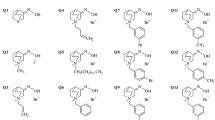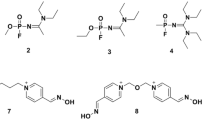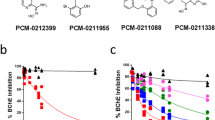Abstract
To date, the only treatments developed for poisoning by organophosphorus compounds, the most toxic chemical weapons of mass destruction, have exhibited limited efficacy and versatility. The available causal antidotes are based on reactivation of the enzyme acetylcholinesterase (AChE), which is rapidly and pseudo-irreversibly inhibited by these agents. In this study, we developed a novel series of monoquaternary reactivators combining permanently charged moieties tethered to position 6- of 3-hydroxypyridine-2-aldoxime reactivating subunit. Highlighted representatives (21, 24, and 27; also coded as K1371, K1374, and K1375, respectively) that contained 1-phenylisoquinolinium, 7-amino-1-phenylisoquinolinium and 4-carbamoylpyridinium moieties as peripheral anionic site ligands, respectively, showed efficacy superior or comparable to that of the clinically used standards. More importantly, these reactivators exhibited wide-spectrum efficacy and were minutely investigated via determination of their reactivation kinetics in parallel with molecular dynamics simulations to study their mechanisms of reactivation of the tabun-inhibited AChE conjugate. To further confirm the potential applicability of these candidates, a mouse in vivo assay was conducted. While K1375 had the lowest acute toxicity and the most suitable pharmacokinetic profile, the oxime K1374 with delayed elimination half-life was the most effective in ameliorating the signs of tabun toxicity. Moreover, both in vitro and in vivo, the versatility of the agents was substantially superior to that of clinically used standards. Their high efficacy and broad-spectrum capability make K1374 and K1375 promising candidates that should be further investigated for their potential as nerve agents and insecticide antidotes.






taken from trajectory 1 at 8 ns for K1371, trajectory 2 at 24 ns for K1374, and trajectory 1 at 45 ns for K1375. The upper panels display the molecule in monomer A, and the lower panels display the molecule in monomer B. The reactivators are represented with balls and sticks, and the serine-tabun conjugate is represented with sticks, with carbon atoms in cyan. The residues lining the active site gorge are represented with sticks, with carbon atoms in white. Water molecules are displayed as lines. The black dashed lines render H-bonds. The distance d(P-Ox) between the phosphorus atom and the oxygen of the oxime functional group is given in Å


Similar content being viewed by others
References
Allgardsson A, Berg L, Akfur C et al (2016) Structure of a prereaction complex between the nerve agent sarin, its biological target acetylcholinesterase, and the antidote HI-6. Proc Natl Acad Sci USA 113:5514–5519. https://doi.org/10.1073/pnas.1523362113
Bajgar J, Fusek J, Kuca K et al (2007) Treatment of organophosphate intoxication using cholinesterase reactivators: facts and fiction. Mini Rev Med Chem 7:461–466
Bartosova L, Kuca K, Kunesova G, Jun D (2006) The acute toxicity of acetylcholinesterase reactivators in mice in relation to their structure. Neurotox Res 9:291–296. https://doi.org/10.1007/BF03033319
Black RM, Harrison JM (2009) The Chemistry of Organophosphorus Chemical Warfare Agents. PATAI’S Chemistry of Functional Groups John Wiley Sons Ltd, New Jersey
Bourne Y, Kolb HC, Radić Z et al (2004) Freeze-frame inhibitor captures acetylcholinesterase in a unique conformation. Proc Natl Acad Sci USA 101:1449–1454. https://doi.org/10.1073/pnas.0308206100
Broomfield CA, Maxwell DM, Solana RP et al (1991) Protection by butyrylcholinesterase against organophosphorus poisoning in nonhuman primates. J Pharmacol Exp Ther 259:633–638
Calas A-G, Hanak A-S, Jaffré N et al (2020) Efficacy assessment of an uncharged reactivator of NOP-inhibited acetylcholinesterase based on tetrahydroacridine pyridine-aldoxime hybrid in mouse compared to pralidoxime. Biomolecules 10:858. https://doi.org/10.3390/biom10060858
Carletti E, Li H, Li B et al (2008) Aging of cholinesterases phosphylated by tabun proceeds through o-dealkylation. J Am Chem Soc 130:16011–16020. https://doi.org/10.1021/ja804941z
Carletti E, Colletier J-P, Schopfer LM et al (2013) Inhibition pathways of the potent organophosphate CBDP with cholinesterases revealed by X-ray crystallographic snapshots and mass spectrometry. Chem Res Toxicol 26:280–289. https://doi.org/10.1021/tx3004505
Darden T, Perera L, Li L (1993) Pedersen L (1999) New tricks for modelers from the crystallography toolkit: the particle mesh Ewald algorithm and its use in nucleic acid simulations. Struct Lond Engl 7:R55-60. https://doi.org/10.1016/s0969-2126(99)80033-1
Dolgin E (2013) Syrian gas attack reinforces need for better anti-sarin drugs. Nat Med 19:1194–1195. https://doi.org/10.1038/nm1013-1194
Driant T, Nachon F, Ollivier C et al (2017) On the influence of the protonation states of active site residues on AChE reactivation: a QM/MM approach. Chembiochem Eur J Chem Biol 18:666–675. https://doi.org/10.1002/cbic.201600646
Ellman GL, Courtney KD, Andres V, Feather-Stone RM (1961) A new and rapid colorimetric determination of acetylcholinesterase activity. Biochem Pharmacol 7:88–95
Elsinghorst PW, Worek F, Thiermann H, Wille T (2013) Drug development for the management of organophosphorus poisoning. Expert Opin Drug Discov 8:1467–1477. https://doi.org/10.1517/17460441.2013.847920
Emsley P, Lohkamp B, Scott WG, Cowtan K (2010) Features and development of Coot. Acta Crystallogr D Biol Crystallogr 66:486–501. https://doi.org/10.1107/S0907444910007493
Gorecki L, Korabecny J, Musilek K et al (2016) SAR study to find optimal cholinesterase reactivator against organophosphorous nerve agents and pesticides. Arch Toxicol 90:2831–2859. https://doi.org/10.1007/s00204-016-1827-3
Gorecki L, Korabecny J, Musilek K et al (2017) Progress in acetylcholinesterase reactivators and in the treatment of organophosphorus intoxication: a patent review (2006–2016). Expert Opin Ther Pat 27:971–985. https://doi.org/10.1080/13543776.2017.1338275
Gorecki L, Soukup O, Kucera T et al (2019) Oxime K203: a drug candidate for the treatment of tabun intoxication. Arch Toxicol 93:673–691. https://doi.org/10.1007/s00204-018-2377-7
Gowda RR, Chakraborty D (2011) FeIII-catalyzed synthesis of primary amides from aldehydes. Eur J Org Chem 2011:2226–2229. https://doi.org/10.1002/ejoc.201001738
Gunnell D, Eddleston M, Phillips MR, Konradsen F (2007) The global distribution of fatal pesticide self-poisoning: systematic review. BMC Public Health 7:357. https://doi.org/10.1186/1471-2458-7-357
Gunnell D, Knipe D, Chang S-S et al (2017) Prevention of suicide with regulations aimed at restricting access to highly hazardous pesticides: a systematic review of the international evidence. Lancet Glob Health 5:e1026–e1037. https://doi.org/10.1016/S2214-109X(17)30299-1
Hepnarova V, Muckova L, Ring A et al (2019) Pharmacological and toxicological in vitro and in vivo effect of higher doses of oxime reactivators. Toxicol Appl Pharmacol 383:114776. https://doi.org/10.1016/j.taap.2019.114776
Humphrey W, Dalke A, Schulten K (1996) VMD: visual molecular dynamics. J Mol Graph 14:33–38. https://doi.org/10.1016/0263-7855(96)00018-5
Karasova JZ, Zemek F, Musilek K, Kuca K (2013) Time-dependent changes of oxime K027 concentrations in different parts of rat central nervous system. Neurotox Res 23:63–68. https://doi.org/10.1007/s12640-012-9329-4
Kassa J, Žďárová Karasová J, Šepsová V, Bajgar J (2011) A comparison of the reactivating and therapeutic efficacy of the newly developed bispyridinium oxime K203 with currently available oximes, in sarin poisoned rats and mice. J Appl Biomed 9:225–230. https://doi.org/10.2478/v10136-011-0011-6
King AM, Aaron CK (2015) Organophosphate and carbamate poisoning. Emerg Med Clin North Am 33:133–151. https://doi.org/10.1016/j.emc.2014.09.010
Kloske M, Witkiewicz Z (2019) Novichoks - the A group of organophosphorus chemical warfare agents. Chemosphere 221:672–682. https://doi.org/10.1016/j.chemosphere.2019.01.054
Kobrlova T, Korabecny J, Soukup O (2019) Current approaches to enhancing oxime reactivator delivery into the brain. Toxicology 423:75–83. https://doi.org/10.1016/j.tox.2019.05.006
Kovarik Z, Katalinić M, Sinko G et al (2010) Pseudo-catalytic scavenging: searching for a suitable reactivator of phosphorylated butyrylcholinesterase. Chem Biol Interact 187:167–171. https://doi.org/10.1016/j.cbi.2010.02.023
Kuca K, Pohanka M (2010) Chemical warfare agents. EXS 100:543–558
Lockridge O (2015) Review of human butyrylcholinesterase structure, function, genetic variants, history of use in the clinic, and potential therapeutic uses. Pharmacol Ther 148:34–46. https://doi.org/10.1016/j.pharmthera.2014.11.011
Mahoney MW, Jorgensen WL (2000) A five-site model for liquid water and the reproduction of the density anomaly by rigid, nonpolarizable potential functions. J Chem Phys 112:8910–8922. https://doi.org/10.1063/1.481505
Maier JA, Martinez C, Kasavajhala K et al (2015) ff14SB: improving the accuracy of protein side chain and backbone parameters from ff99SB. J Chem Theory Comput 11:3696–3713. https://doi.org/10.1021/acs.jctc.5b00255
Malinak D, Dolezal R, Hepnarova V et al (2020) Synthesis, in vitro screening and molecular docking of isoquinolinium-5-carbaldoximes as acetylcholinesterase and butyrylcholinesterase reactivators. J Enzyme Inhib Med Chem 35:478–488. https://doi.org/10.1080/14756366.2019.1710501
Marrs TC (1993) Organophosphate poisoning. Pharmacol Ther 58:51–66
Mercey G, Verdelet T, Saint-André G et al (2011) First efficient uncharged reactivators for the dephosphylation of poisoned human acetylcholinesterase. Chem Commun Camb Engl 47:5295–5297. https://doi.org/10.1039/c1cc10787a
Mercey G, Renou J, Verdelet T et al (2012) Phenyltetrahydroisoquinoline-pyridinaldoxime conjugates as efficient uncharged reactivators for the dephosphylation of inhibited human acetylcholinesterase. J Med Chem 55:10791–10795. https://doi.org/10.1021/jm3015519
Mew EJ, Padmanathan P, Konradsen F et al (2017) The global burden of fatal self-poisoning with pesticides 2006–15: systematic review. J Affect Disord 219:93–104. https://doi.org/10.1016/j.jad.2017.05.002
Moriarty NW, Grosse-Kunstleve RW, Adams PD (2009) electronic ligand builder and optimization workbench (eLBOW): a tool for ligand coordinate and restraint generation. Acta Crystallogr D Biol Crystallogr 65:1074–1080. https://doi.org/10.1107/S0907444909029436
Musilek K, Komloova M, Holas O et al (2011) Mono-oxime bisquaternary acetylcholinesterase reactivators with prop-1,3-diyl linkage-Preparation, in vitro screening and molecular docking. Bioorg Med Chem 19:754–762. https://doi.org/10.1016/j.bmc.2010.12.021
Nachon F, Carletti E, Worek F, Masson P (2010) Aging mechanism of butyrylcholinesterase inhibited by an N-methyl analogue of tabun: Implications of the trigonal–bipyramidal transition state rearrangement for the phosphylation or reactivation of cholinesterases. Chem Biol Interact 187:44–48. https://doi.org/10.1016/j.cbi.2010.03.053
Paddock RC, Sang-Hun C (2017) Kim Jong-nam Was Killed by VX Nerve Agent. Malaysians Say, NY
Petroianu GA, Arafat K, Nurulain SM et al (2007) In vitro oxime reactivation of red blood cell acetylcholinesterase inhibited by methyl-paraoxon. J Appl Toxicol JAT 27:168–175. https://doi.org/10.1002/jat.1189
Pettersen EF, Goddard TD, Huang CC et al (2004) UCSF Chimera–a visualization system for exploratory research and analysis. J Comput Chem 25:1605–1612. https://doi.org/10.1002/jcc.20084
Pronk S, Páll S, Schulz R et al (2013) GROMACS 4.5: a high-throughput and highly parallel open source molecular simulation toolkit. Bioinformatics 29:845–854. https://doi.org/10.1093/bioinformatics/btt055
Rosenberg YJ, Mao L, Jiang X et al (2017) Post-exposure treatment with the oxime RS194B rapidly reverses early and advanced symptoms in macaques exposed to sarin vapor. Chem Biol Interact 274:50–57. https://doi.org/10.1016/j.cbi.2017.07.003
Rosenberg YJ, Wang J, Ooms T et al (2018) Post-exposure treatment with the oxime RS194B rapidly reactivates and reverses advanced symptoms of lethal inhaled paraoxon in macaques. Toxicol Lett 293:229–234. https://doi.org/10.1016/j.toxlet.2017.10.025
Saint-André G, Kliachyna M, Kodepelly S et al (2011) Design, synthesis and evaluation of new α-nucleophiles for the hydrolysis of organophosphorus nerve agents: application to the reactivation of phosphorylated acetylcholinesterase. Tetrahedron 67:6352–6361. https://doi.org/10.1016/j.tet.2011.05.130
Seiple IB, Su S, Rodriguez RA et al (2010) Direct C−H arylation of electron-deficient heterocycles with arylboronic acids. J Am Chem Soc 132:13194–13196. https://doi.org/10.1021/ja1066459
Sit RK, Fokin VV, Amitai G et al (2014) Imidazole aldoximes effective in assisting butyrylcholinesterase catalysis of organophosphate detoxification. J Med Chem 57:1378–1389. https://doi.org/10.1021/jm401650z
Sit RK, Kovarik Z, Maček Hrvat N et al (2018) Pharmacology, pharmacokinetics, and tissue disposition of zwitterionic hydroxyiminoacetamido alkylamines as reactivating antidotes for organophosphate exposure. J Pharmacol Exp Ther 367:363–372. https://doi.org/10.1124/jpet.118.249383
Soukup O, Korabecny J, Malinak D et al (2018) In vitro and in silico evaluation of non-quaternary reactivators of ache as antidotes of organophosphorus poisoning - a new hope or a blind alley? Med Chem Shariqah United Arab Emir 14:281–292. https://doi.org/10.2174/1573406414666180112105657
Sousa da Silva AW, Vranken WF (2012) ACPYPE - antechamber python parser interface. BMC Res Notes 5:367. https://doi.org/10.1186/1756-0500-5-367
Tallarida R, Murray RB (1987) Manual of pharmacologic calculations: with computer programs, 2nd edn. Springer-Verlag, New York
Vanquelef E, Simon S, Marquant G et al (2011) R.E.D. Server: a web service for deriving RESP and ESP charges and building force field libraries for new molecules and molecular fragments. Nucleic Acids Res 39:W511–W517. https://doi.org/10.1093/nar/gkr288
Wang J, Wolf RM, Caldwell JW et al (2004) Development and testing of a general amber force field. J Comput Chem 25:1157–1174. https://doi.org/10.1002/jcc.20035
Wang J, Wang W, Kollman PA, Case DA (2006) Automatic atom type and bond type perception in molecular mechanical calculations. J Mol Graph Model 25:247–260. https://doi.org/10.1016/j.jmgm.2005.12.005
Watson A, Opresko D, Young RA et al (2015) Organophosphate Nerve Agents. Handbook of Toxicology of Chemical Warfare Agents. Elsevier, London, pp 87–109
Wong L, Radic Z, Brüggemann RJ et al (2000) Mechanism of oxime reactivation of acetylcholinesterase analyzed by chirality and mutagenesis. Biochemistry 39:5750–5757
Worek F, Mast U, Kiderlen D et al (1999) Improved determination of acetylcholinesterase activity in human whole blood. Clin Chim Acta 288:73–90. https://doi.org/10.1016/S0009-8981(99)00144-8
Worek F, Thiermann H, Szinicz L, Eyer P (2004) Kinetic analysis of interactions between human acetylcholinesterase, structurally different organophosphorus compounds and oximes. Biochem Pharmacol 68:2237–2248. https://doi.org/10.1016/j.bcp.2004.07.038
Worek F, Wille T, Koller M, Thiermann H (2012) Reactivation kinetics of a series of related bispyridinium oximes with organophosphate-inhibited human acetylcholinesterase—Structure–activity relationships. Biochem Pharmacol 83:1700–1706. https://doi.org/10.1016/j.bcp.2012.03.002
Zdarova Karasova J, Hepnarova V, Andrys R et al (2020) Encapsulation of oxime K027 into cucurbit[7]uril: In vivo evaluation of safety, absorption, brain distribution and reactivation effectiveness. Toxicol Lett 320:64–72. https://doi.org/10.1016/j.toxlet.2019.11.021
Zhu Z, Furr J, Buolamwini JK (2003) Synthesis and flow cytometric evaluation of novel 1,2,3,4-tetrahydroisoquinoline conformationally constrained analogues of nitrobenzylmercaptopurine riboside (NBMPR) designed for probing its conformation when bound to the es nucleoside transporter. J Med Chem 46:831–837. https://doi.org/10.1021/jm020405p
Zorbaz T, Malinak D, Maraković N et al (2018) Pyridinium oximes with ortho-positioned chlorine moiety exhibit improved physicochemical properties and efficient reactivation of human acetylcholinesterase inhibited by several nerve agents. J Med Chem 61:10753–10766. https://doi.org/10.1021/acs.jmedchem.8b01398
Zorbaz T, Mišetić P, Probst N et al (2020) Pharmacokinetic evaluation of brain penetrating morpholine-3-hydroxy-2-pyridine oxime as an antidote for nerve agent poisoning. ACS Chem Neurosci. https://doi.org/10.1021/acschemneuro.0c00032
Acknowledgements
The work was supported by a grant from the Ministry of Health of the Czech Republic (no. 17-32801A), by the Long-term development plan (Faculty of Military Health Sciences), University of Hradec Kralove (no. VT2019-2021), and by the French Ministry of Armed Forces (Direction Générale de l'Armement and Service de Santé des Armées) under contract NBC-5-C-4210.
Author information
Authors and Affiliations
Contributions
Development of versatile and highly potent monoquaternary reactivators of acetylcholinesterase. LG—chemical synthesis, design of the compounds, manuscript writing. VH—in vitro determination of cholinesterase reactivation, in vivo experiments. JZK—in vivo experiments, functional observation battery assessment, pharmacokinetic assessment. MH—in vitro determination of cholinesterase reactivation. CC—enzyme production and purification. JD—enzyme production and purification. TK—prediction of the compound's binding pattern into cholinesterases using in silico techniques. TK—prediction of the blood–brain barrier permeation. LM—cytotoxicity evaluation. LP—high-resolution mass spectrometry analysis of the compounds, pharmacokinetic assessment. DM—chemical synthesis, NMR data interpretation. DJ—in vitro determination of cholinesterase reactivation. KM—chemical synthesis, design of the study. FW—kinetics determination of cholinesterase reactivation. FN—in silico analysis—molecular dynamics. OS—manuscript writing, in vivo toxicity determination, design study. JK—data interpretation, chemical synthesis, manuscript writing, design study.
Corresponding authors
Ethics declarations
Conflict of interest
The authors declare that there are no conflicts of interest.
Additional information
Publisher's Note
Springer Nature remains neutral with regard to jurisdictional claims in published maps and institutional affiliations.
Supplementary Information
Below is the link to the electronic supplementary material.
Rights and permissions
About this article
Cite this article
Gorecki, L., Hepnarova, V., Karasova, J.Z. et al. Development of versatile and potent monoquaternary reactivators of acetylcholinesterase. Arch Toxicol 95, 985–1001 (2021). https://doi.org/10.1007/s00204-021-02981-w
Received:
Accepted:
Published:
Issue Date:
DOI: https://doi.org/10.1007/s00204-021-02981-w




